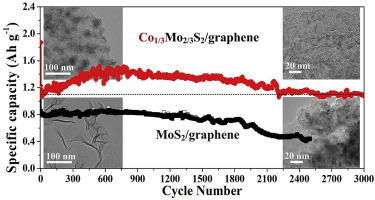Journal of Power Sources ( IF 9.2 ) Pub Date : 2017-11-08 , DOI: 10.1016/j.jpowsour.2017.10.094 Xiaomin Li , Zhenxing Feng , Jiantao Zai , Zi-Feng Ma , Xuefeng Qian

|
Layered transition metal dichalcogenides are promising as lithium and/or sodium storage materials for lithium and sodium (Li/Na) ion batteries. However they always exhibit limited rate capability and long-term cycling stability, due to the fact that their 2D structures are easily restacking and agglomeration during cycling process and further result poor electrochemical reversibility. Herein, hierarchical Co1/3Mo2/3S2/graphene nanocomposites without CoSx and MoS2 impurities have been synthesized via one-pot solvothermal process. The incorporation of Co into MoS2 at atomic level can not only give rise to thinner and smaller nanosheets in the nanocomposites than MoS2/graphene nanocomposites, but also significantly decrease the size of in-situ formed MoS2/CoSx nanoparticles during electrochemical conversion process, which can greatly promoting the ion diffusion and suppressing the aggregation of active materials. Furthermore, the conductivity of Co1/3Mo2/3S2/graphene nanocomposites can be enhanced from 0.46 S m−1 (MoS2/graphene) to 1.39 S m−1 via changing the semiconducting MoS2 to metallic Co1/3Mo2/3S2. The simultaneously optimized electron conductivity and ions diffusion dynamics of Co1/3Mo2/3S2/graphene nanocomposites can effectively improve the reversibility of electrochemical conversion reactions. A capacity of 940 mAh g−1 and 529 mAh g−1 can be maintained at 3200th cycle (2 A g−1) in lithium-ion batteries and 200th cycle (1 A g−1) in sodium-ion batteries, respectively.
中文翻译:

将Co掺入MoS 2 /石墨烯纳米复合材料:一种增强Li / Na储存循环稳定性的有效方法
层状过渡金属二卤化物有望用作锂和钠(Li / Na)离子电池的锂和/或钠存储材料。然而,由于它们的2D结构在循环过程中易于重新堆积和附聚,并且进一步导致较差的电化学可逆性,因此它们始终显示出有限的速率能力和长期循环稳定性。在此,已经通过一锅溶剂热法合成了没有CoS x和MoS 2杂质的分级Co 1/3 Mo 2/3 S 2 /石墨烯纳米复合材料。将Co掺入MoS 2中在原子水平上,不仅可以使纳米复合材料中的纳米片比MoS 2 /石墨烯纳米复合物更薄,更小,而且可以显着减小电化学转化过程中原位形成的MoS 2 / CoS x纳米粒子的尺寸,从而可以大大促进纳米复合材料的发展。离子扩散并抑制活性物质的聚集。此外,通过将半导体MoS 2更改为金属Co,可以将Co 1/3 Mo 2/3 S 2 /石墨烯纳米复合材料的电导率从0.46 S m -1(MoS 2 /石墨烯)提高到1.39 S m -1 。1/3 Mo 2/3 S 2。同时优化Co 1/3 Mo 2/3 S 2 /石墨烯纳米复合材料的电子电导率和离子扩散动力学可有效提高电化学转化反应的可逆性。锂离子电池的第3200次循环(2 A g -1)和钠离子电池的第200次循环(1 A g -1)可以分别维持940 mAh g -1和529 mAh g -1的容量。



























 京公网安备 11010802027423号
京公网安备 11010802027423号